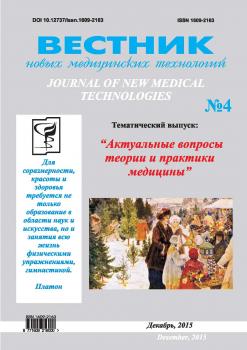The article presents three approaches (deterministic, stochastic and chaotic – self-organizing) for studying biomedical systems. The authors show that complex biosystems cann’t be described by deterministic and stochastics because of constant changing parameters xi of a state vector of such systems x=x(t). The fundamental distinguish of deterministic and stochastic systems from chaotic – self-organizing is continuous movement x(t) in phase space of states. The authors also present complex of objects which the authors have been studying for the last 30 years and which conform the type III systems. The particular features of the personalized medicine are presented, that denies possibility of identification of body state at one measurement (a point in a phase space). It is connected with the fact that there is a uniform distribution x(t) in time-domain xi which is revealed in continuous change of distribution functions f(x) for different discrete recording time-domain x(t) at all xi. The authors assert that behavior dynamics of neural networks is similar to work of neuroemulators that is terminated by certainty in quasi-attractor’s volumes.
determinism, stochastics, chaos, personalized medicine, quasi-attractor
1. Anokhin P.K. Kibernetika funktsional´nykh sis-tem. M.: Meditsina, 1998. 285 s.
2. Bernshteyn N.A. Biomekhanika i fiziologiya dvi-zheniy. / Pod red. V. P. Zinchenko. M.: Izd-vo instituta prakt. psikhologii; Voronezh: NPO “MODEK”, 1997. 608 s.
3. Es´kov V.M. Avtomaticheskaya identifikatsiya dif-ferentsial´nykh uravneniy, modeliruyushchikh neyronnye seti. Izmeritel´naya tekhnika. 1994. № 3. S. 37-41
4. Es´kov V.M. Filatova O.E. Komp´yuternaya identi-fikatsiya ierarkhicheskikh kompartmentnykh neyronnykh setey. Izmeritel´naya tekhnika. 1994. № 8. S. 27-30.
5. Es´kov V.M., Kulaev S.V., Popov Yu.M., Filatova O.E. Primenenie komp´yuternykh tekhnologiy pri izmerenii nestabil´nosti v statsionarnykh rezhimakh biologicheskikh dinamicheskikh sistem. Izmeritel´naya tekhnika. 2006. №1. S. 40-45.
6. Es´kov V.M., Khadartsev A.A., Es´kov V.V., Filatova O.E. Osobennosti izmereniy i modelirovaniya biosistem v fazovykh prostranstvakh sostoyaniy. Izmeritel´naya tekhnika. 2010. №12. S.53-57.
7. Es´kov V.M. Gorizonty budushchego i Manuel´ Kas-tells: real´nosti i illyuzii otnositel´no informatsionnoy tekhnologii, global´nogo kapitalizma i setevogo obshchestva. V.I. Vernadskiy i noosfernaya paradigma razvitiya obshchestva, nauki, kul´tury, obrazovaniya i ekonomiki v XXI veke kollektivnaya monografiya / Pod nauch. red. A.I. Subetto i V.A. Shamakhova. V 3-kh tomakh. Tom 1. SPb.: Asterion, 2013. C. 557-573.
8. Es´kov V.M., Khadartsev A.A., Es´kov V.V., Dzhumaga-lieva L.V. Nauka o zhivom i filosofiya zhivogo v inter-pretatsii V.I. Vernadskogo i sovremennoy teorii khaosa-samoorganizatsii kak osnova tret´ey paradigmy estestvoznaniya. V.I. Vernadskiy i noosfernaya paradigma razvitiya obshchestva, nauki, kul´tury, obrazovaniya i ekonomiki v XXI veke kollektivnaya monografiya / Pod nauch. red. A.I. Subetto i V.A. Shamakhova. V 3-kh tomakh. Tom 2. SPb.: Asterion, 2013. S. 188-208.
9. Es´kov V.M., Khadartsev A.A., Filatov M.A., Gavri-lenko T.V. Perspektivy razvitiya chelovechestva s pozitsiy noosfery i tret´ey paradigmy. V.I. Vernadskiy i noosfernaya paradigma razvitiya obshchestva, nauki, kul´tury, obrazovaniya i ekonomiki v XXI veke kollektivnaya monografiya / Pod nauch. red. A.I. Subetto i V.A. Shamakhova. V 3-kh tomakh. Tom 3. SPb.: Asterion, 2013. S. 502-510.
10. Interv´yu s S.P. Kurdyumovym. Voprosy filo-sofii. 1991. № 6. S. 53-57.
11. Prigozhin I.R. Filosofiya nestabil´nosti (perevod Ya.I. Sviridova). Voprosy filosofii. 1991. №6. S. 47-52.
12. Sinergetike - 30 let: Interv´yu s G. Khakenom. Voprosy filosofii. 2000. № 3. S. 53-61.
13. Khorgan Dzh.. Konets nauki: Vzglyad na ogranichen-nost´ znaniya na zakate Veka Nauki. SPb.: Amfora, 2011. 479 s.
14. Es´kov V.M., Zilov V.G., Khadartsev A.A. Novye podkhody v teoreticheskoy biologii i meditsine na baze teorii khaosa i sinergetiki. Sistemnyy analiz i upravlenie v biomeditsinskikh sistemakh. 2006. T. 5. № 3. S. 617-623.
15. Churchland M.M., Cunningham J.P., Kaufman M.T. and others. Neural population dynamics during reaching. Nature. 2012. V. 487. P. 51-56.
16. Eskov V.M. Models of hierarchical respiratory neuron networks. Neurocomputing. 1996. V. 11. № 2-4. P. 203-226.
17. Eskov V.M. Computer technologies in stability measurements on stationary states in dynamic biological systems. Measurement Techniques. 2006. V. 49. N. 1. P. 59-65.
18. Characteristic features of measurements and modeling for biosystems in phase spaces of states / Eskov V.M., Filatova O.E. [et al.]// Measurement Techniques (Medical and Biological Measurements). 2011. V. 53. № 12. P. 1404-1410.
19. Eskov V. M., Gavrilenko T. V., Kozlova V. V., Fila-tov M.A. Measurement of the dynamic parameters of micro-chaos in the behavior of living biosystems. Measurement Techniques. 2012. V. 55. №9. P. 1096-1101.
20. Eskov V.M. Evolution of the emergent properties of three types of societies: the basic law of human development. Emergence: Complexity & Organization. 2014. V. 16(2). P. 109-117.
21. Haken H. Principles of brain functioning: a synergetic approach to brain activity, behavior and cognition (Springer series in synergetics). Springer. 1995. 349 P.
22. Mayr E.W. What evolution is / Basic Books; New York, 2001, 349p.
23. Prigogine I. The philosophiy of instability. Futures, 1989, p. 396-400.
24. Prigogine I. The Die Is Not Cast. Futures. Bulletin of the Word Futures Studies Federation. 2000. Vol. 25. № 4. P. 17-19.
25. Weaver W. Science and Complexity. Rokfeller Foundation, New York City. American Scientist. 1948. V. 36. P. 536-544.





